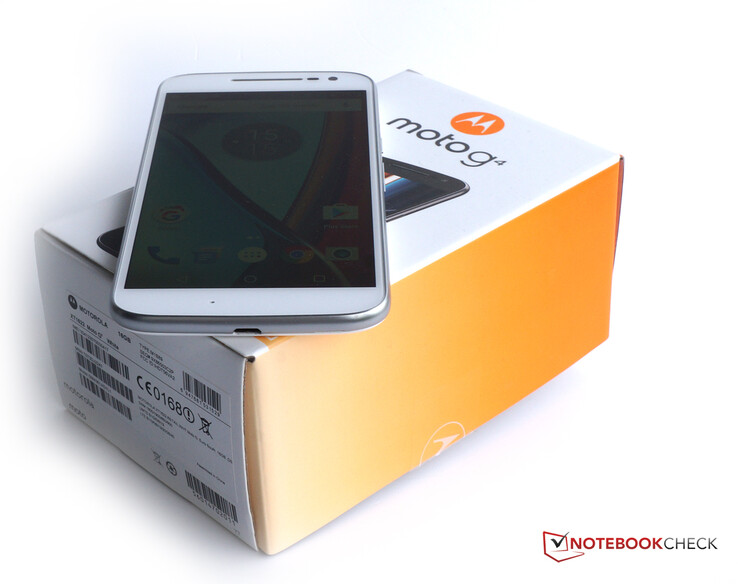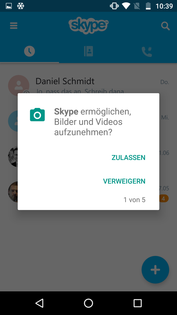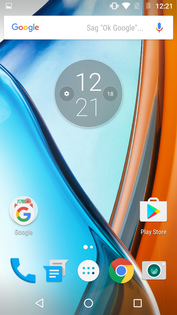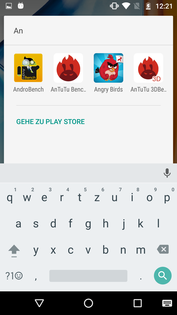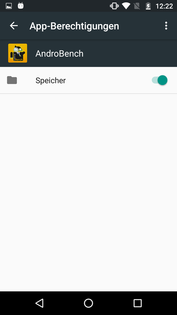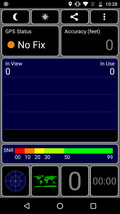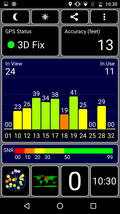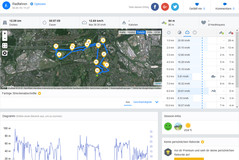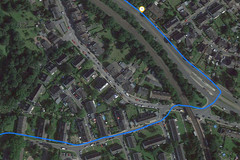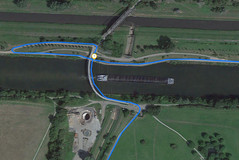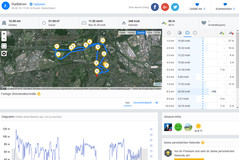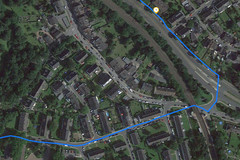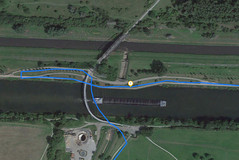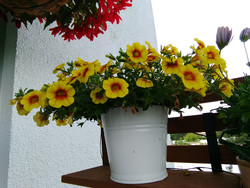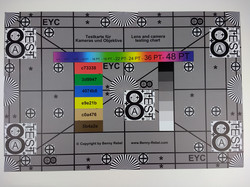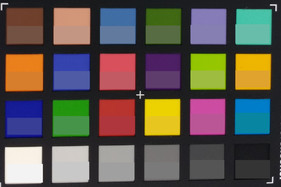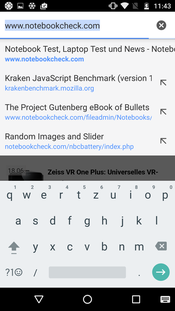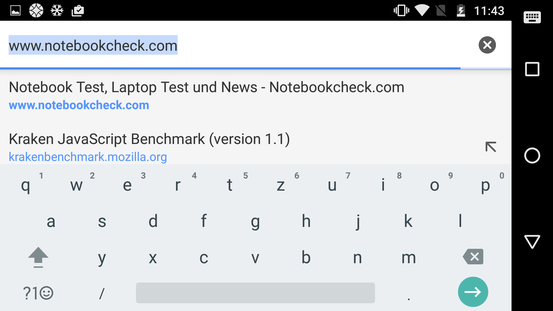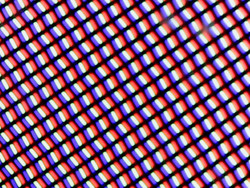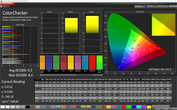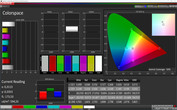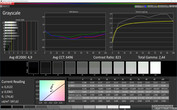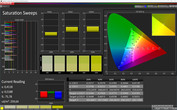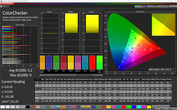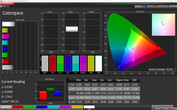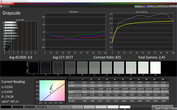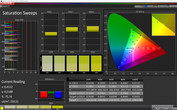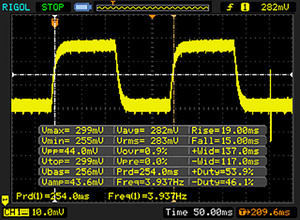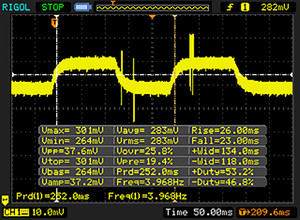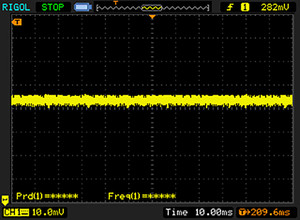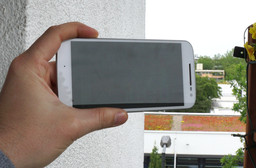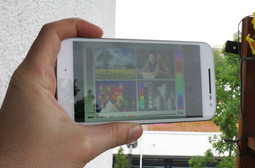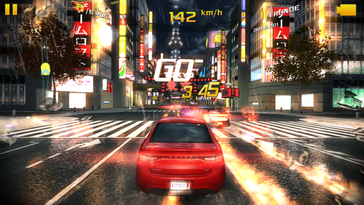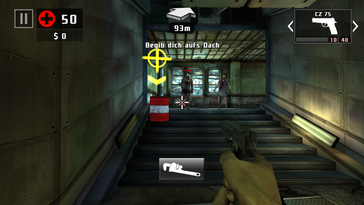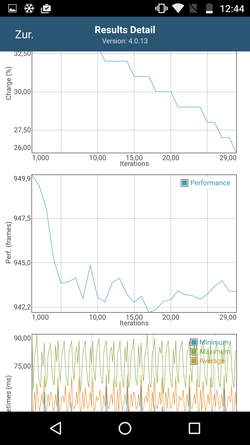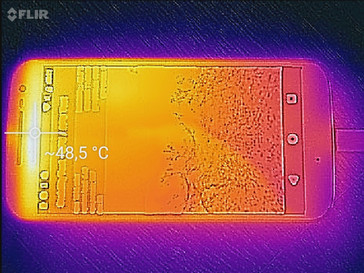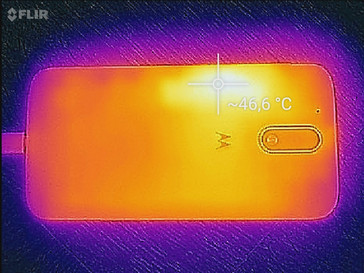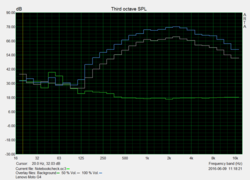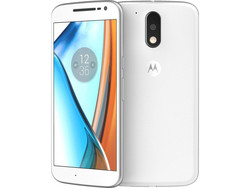Lenovo Moto G4 Smartphone Review
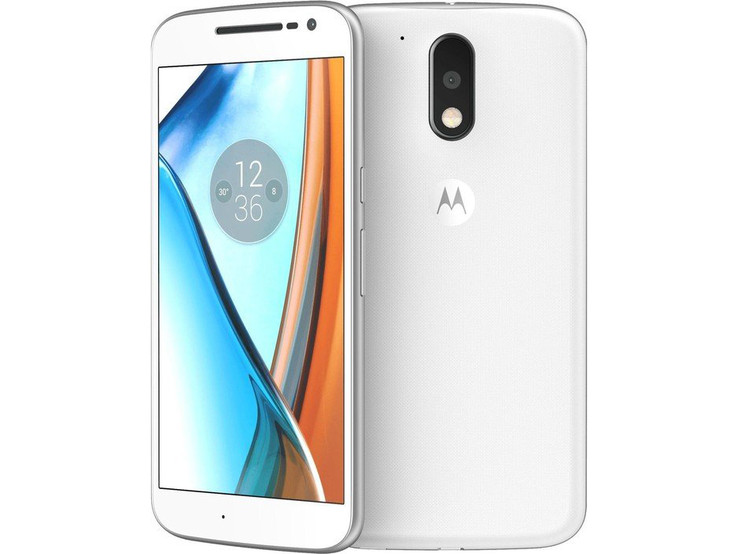
For the original German review, see here.
Offering multiple versions of a smartphone has advantages for both the manufacturer and customers: The manufacturer can address more customers without developing a completely new device. This is also the case for the new Moto G4 from Motorola or Lenovo, respectively. You can get the Moto G4 and the Moto G4 Plus, which is pretty much the same smartphone, but with more features. The customer can decide: Pay slightly more to get more features or save some money and waive some stuff you probably do not need.
The cheapest model of the Moto G4 with 16 GB storage retails for 249 Euros (~$274), while the Moto G4 Plus with 32 GB costs at least 299 Euros (~$329), so the difference is 50 Euros (~$55). However, it does not make a lot of sense to get the 32 GB version of the Moto G4 (only available via MotoMaker on Motorola's website), because it is only 5% (15 Euros, ~$16) less expensive than the Moto G4 Plus. By the way, retail units will only be available with 16 GB internal storage.
Comparison devices for the Moto G4 are similar to the Moto G4 Plus: The predecessor Moto G (3rd Gen) and Honor 5X, Huawei P9 Lite or OnePlus 2.
Case
The cases of the Moto G4 and Moto G4 Plus hardly differ at all: The Moto G4 obviously lacks the noticeable fingerprint scanner at the rear of the Plus model. You can also notice the lack of the diode for the laser autofocus at the rear camera module. Otherwise, however, the cases of the two models are actually identical.
Retail versions of the Moto G4 will also be limited to black and white, but you can customize it comprehensively via MotoMaker. More on that topic in our review of the Moto G4 Plus.
There are no differences in respect of the weight: Both smartphones are comparatively light at 155 grams. The charger of the Moto G4 is also lighter, because it lacks the quick-charging support, so the total weight is lower.
The quality of the Moto G4's plastic chassis is very good: Pressure from the front or the back has no effect on the screen. The device feels very good in the hand due to the rounded corners. You can detach the back cover, which will give you access to both SIM slots and the microSD slot. It is not possible to replace the battery.
Connectivity
You get 16 GB storage and 2 GB RAM when you buy the Moto G4 at your local dealer, but there is also a version with 32 GB via MotoMaker for 35 Euros (~$38) more. A microSD slot for cards with up to 128 GB is also available, and apps can be transferred to the memory card. It can also be formatted as internal storage, but you should use a fast SD card in this case.
USB-OTG is supported, so you can also attach external storage solutions via USB port. NFC on the other hand is not available.
Software
Lenovo and Motorola use "MotoPure", which just means they use the stock Android from Google. One advantage of this solution is the quick distribution of updates, and it is also supposed to increase the performance according to Lenovo. The smartphone uses version 6.0.1 of this Vanilla Android with security patches from May 1st 2016. Handy in this Android version: You can manage rights for apps, which means better protection against spying apps.
Except for the Moto app, which controls some special features, and a Help function, there are actually no other apps, so users get as much storage as possible for their own apps and files.
Communication & GPS
Similar to the bigger sibling, the Moto G4 also supports four GSM, four UMTS and nine LTE bands (maximum downstream/upstream: 150 Mbps/50 Mbps). All important European frequencies are covered, but only some frequencies in America and Asia. There can be some blank spaces, but the Moto G4 is generally still suited for frequent travelers.
The signal quality was good in the well-developed metropolitan Vodafone network: You can usually expect at least 3/4 LTE bars, even indoors.
The Moto G4 supports wireless networks according to 802.11 a/b/g/n. You can therefore use 5 GHz networks and fast networks with a maximum transfer rate of 300 Mbps. With a distance of ten meters to the router (FritzBox 6490) and three walls in between, we still had 50% of the signal, and webpages loaded just as quickly as in direct proximity to the router. Another three meters and another wall resulted in 1/4 bars and the performance was a bit slower.
The GPS module cannot locate the smartphone indoors. It also takes a while outdoors, but the position will be accurate down to four meters.
We take the Moto G4 on a bicycle ride for a better evaluation of the GPS performance, and we compare the results with the professional navigation device Garmin Edge 500. The measured distance only differs by 10 meters, which is very good. The professional system is still more accurate, since the Moto G4 sometimes just draws a straight line when it does not locate the position for a longer period. The crossing section is not a big problem for the Moto G4, but we can see some inaccuracies at the river section: We hover across the river and apparently ride through fields, even though we always stayed on the path.
Telephone & Voice Quality
You will know the phone app if you have ever used Android before and Lenovo did not customize it. The default view is your list with favorites and there are tabs for call history and contacts. A search field at the top is always available, and you can also access the number pad all the time.
The voice quality is similar to the Moto G4 Plus: Pretty good, but we also reviewed smartphones with a much better quality. The ear piece heavily distorts at high volumes, the microphone has problems with quiet voices and there is also some noise. Hands-free works pretty well, and the sound via speaker is pretty clear.
Cameras
The main camera is one of the big differences between the Moto G4 and Moto G4 Plus: The better equipped model gets a 16 MP sensor with a laser autofocus, which works really good in low-light situations. We liked the camera of the Moto G4 Plus.
So what about our review unit? The Moto G4 uses a 13 MP sensor without any highlights except for the dual-flash. The aperture of f/2.0 is similar to the Moto G4 Plus, so it should collect a lot of light in darker environments, but there might be some bloom at brighter surfaces.
One area where the Moto G4 performs better is the color temperature of the pictures: They appear much warmer and more natural on the Moto G4 compared to the bigger sibling, which suffered from a blue cast. We can once again notice some bloom at bright surfaces and the edges in front of these surfaces are blurry. The Moto G4 Plus clearly takes sharper images with more details, and pictures with our review unit are generally a bit darker.
Our review unit performs well in low-light situations, but there is much less picture noise in the case of the iPhone 6S Plus, for example, and the OnePlus 2 takes brighter pictures, so you can see more details.
Videos on the Moto G4 can be recorded in 1080p and up to 30 frames per second, which is also the case for the comparison devices. Fast movements are obviously not as smooth as 60 fps recordings, but otherwise, we like the video quality. A great feature of Google’s Video app is the seamless brightness control via finger, so you can create smooth transitions between bright and dark environments, for instance.
The front camera with a wide-angle lens and 5 MP works well. It is sufficient for selfies and we also like the colors.
We take a picture of our reference chart under controlled lighting conditions for a closer evaluation of the sharpness and the colors. The sharpness is even a bit better compared to the Moto G4 Plus, but the peripheral areas appear a bit blurry and there is also some grain in general when you have a closer look. This is also noticeable when you zoom in, but the sharpness is still good.
Colors are brighter compared to the Moto G4 Plus, but once again darker and more saturated compared to the reference colors. White has a clearly visible beige-cast, similar to the bigger sibling.
Accessories & Warranty
Neither model of the Moto G4 is shipped with a headset. Except for a power adapter and a USB cable, you will only find a quick-start guide as well as a warranty card in the box. Motorola currently does not sell dedicated accessories for the devices. Unfortunate: The rear covers could be offered in multiple colors. They are available in the MotoMaker, but you cannot buy them separately yet.
The warranty period is 12 months.
Input Devices & Handling
The virtual keyboard from Google just got an update and you now get an additional row with numbers and a special mode for passwords. It is easier to control the cursor by swiping across the space bar, and you can adjust the height of the input. We still think the layout is simple and we like the clear design in particular. Still, this is a matter of taste, and you can download other models from the Play Store. You should, however, look for a trustworthy provider, since the keyboard app could transmit keyboard inputs to the app provider.
The Android buttons are implemented as software buttons; Lenovo wanted to offer a pure Android experience without touch or even hardware buttons for "Back", "Home" and "App-Overview". This means the available space on the screen is sometimes reduced. The volume rocker at the side has a well-defined pressure point. The standby button is above the rocker and is ribbed, so it is easier to find with the finger.
The touchscreen is also precise in the peripheral areas. Touch gestures are pretty much the only thing Lenovo adds to the stock Android: Lifting the smartphone will deactivate the ringtone, putting it on its display will deactivate notifications and the device will not ring. Turning the wrist twice (with the smartphone in your hand) will activate the camera; moving the hand down will activate the flashlight. The latter is, however, not always very accurate in hectic situations and requires some practice. A link to the home screen is often the better choice.
Handy: The Lenovo Moto G4 can also display notifications and the time on the standby screen – a familiar feature seen with Motorola devices for a while now. The smartphone reacts when you lift it. You can also turn it off to save power in standby, but it is already optimized in respect to the consumption based on our experiences and also according to Lenovo.
Display
Just like the Moto G4 Plus, our review unit is equipped with a 5.5-inch IPS screen and a resolution of 1920x1080 pixels. However, the screen of the Moto G4 is even considerably brighter. We can measure 723.3 cd/m² on average, which is a really good result also within the comparison group. You can only use it with the brightness sensor though, and the luminance is much lower in the manual mode. The more realistic APL50 test determines a maximum luminance of 724 cd/m².
The brightness distribution is similar to the Moto G4 Plus at 87% and is sufficient to display consistent colored areas.
| |||||||||||||||||||||||||
Brightness Distribution: 87 %
Center on Battery: 724 cd/m²
Contrast: 1020:1 (Black: 0.71 cd/m²)
ΔE ColorChecker Calman: 4.5 | ∀{0.5-29.43 Ø4.78}
ΔE Greyscale Calman: 4.9 | ∀{0.09-98 Ø5}
Gamma: 2.44
CCT: 6496 K
| Lenovo Moto G4 IPS, 1920x1080, 5.5" | OnePlus 2 IPS, 1920x1080, 5.5" | Honor 5X IPS, 1920x1080, 5.5" | Huawei P9 Lite IPS, 1920x1080, 5.2" | Motorola Moto G 3. Gen 2015 XT1541 IPS, 1280x720, 5" | Lenovo Moto G4 Plus IPS, 1920x1080, 5.5" | |
|---|---|---|---|---|---|---|
| Screen | 9% | -2% | -8% | -4% | 3% | |
| Brightness middle (cd/m²) | 724 | 451 -38% | 535 -26% | 505 -30% | 418 -42% | 609 -16% |
| Brightness (cd/m²) | 723 | 446 -38% | 521 -28% | 468 -35% | 407 -44% | 589 -19% |
| Brightness Distribution (%) | 87 | 90 3% | 85 -2% | 88 1% | 95 9% | 87 0% |
| Black Level * (cd/m²) | 0.71 | 0.3 58% | 0.43 39% | 0.74 -4% | 0.49 31% | 0.63 11% |
| Contrast (:1) | 1020 | 1503 47% | 1244 22% | 682 -33% | 853 -16% | 967 -5% |
| Colorchecker dE 2000 * | 4.5 | 3.84 15% | 4.88 -8% | 4.1 9% | 3.92 13% | 3.8 16% |
| Colorchecker dE 2000 max. * | 8.4 | 8.66 -3% | 5.8 31% | 8.3 1% | ||
| Greyscale dE 2000 * | 4.9 | 3.97 19% | 5.2 -6% | 4.9 -0% | 3.81 22% | 3.1 37% |
| Gamma | 2.44 90% | 2.46 89% | 2.26 97% | 2.5 88% | 2.27 97% | 2.06 107% |
| CCT | 6496 100% | 7283 89% | 7766 84% | 7116 91% | 7361 88% | 6725 97% |
| Color Space (Percent of AdobeRGB 1998) (%) | 58.07 | |||||
| Color Space (Percent of sRGB) (%) | 90.14 |
* ... smaller is better
Another similarity to the Moto G4 Plus: The black value is pretty high. 0.71 cd/m² (even 0.73 cd/m² with APL50) in our measurements results in surfaces that are not really black but dark gray, especially with high brightness settings. The contrast ratio of 1020:1 is good thanks to the high luminance.
Subjectively, the picture appears to be very bright. If you increase the luminance, you are almost dazzled by white surfaces. Colors look rich and white surfaces look slightly beige. The presentation is sharp thanks to the Full HD resolution, and we cannot see aliasing at fonts or individual pixels.
We use the software CalMAN and a spectrophotometer for objective results. Here we can see high deviations compared to the sRGB reference color space, especially in comparison with the rivals. The color temperature on the other hand is low, so we could not notice a blue cast, and the colors were actually a bit too green. There is also the possibility to change the setting to "Intense", but the differences are hard to see, both with the eye and with the measurements.
Display Response Times
| ↔ Response Time Black to White | ||
|---|---|---|
| 34 ms ... rise ↗ and fall ↘ combined | ↗ 19 ms rise | |
| ↘ 15 ms fall | ||
| The screen shows slow response rates in our tests and will be unsatisfactory for gamers. In comparison, all tested devices range from 0.1 (minimum) to 240 (maximum) ms. » 90 % of all devices are better. This means that the measured response time is worse than the average of all tested devices (20.2 ms). | ||
| ↔ Response Time 50% Grey to 80% Grey | ||
| 49 ms ... rise ↗ and fall ↘ combined | ↗ 26 ms rise | |
| ↘ 23 ms fall | ||
| The screen shows slow response rates in our tests and will be unsatisfactory for gamers. In comparison, all tested devices range from 0.165 (minimum) to 636 (maximum) ms. » 84 % of all devices are better. This means that the measured response time is worse than the average of all tested devices (31.6 ms). | ||
Screen Flickering / PWM (Pulse-Width Modulation)
| Screen flickering / PWM not detected | |||
In comparison: 53 % of all tested devices do not use PWM to dim the display. If PWM was detected, an average of 8108 (minimum: 5 - maximum: 343500) Hz was measured. | |||
The picture shows very stable colors and contrasts from all sides, even from flat angles. Even multiple users can look at the display simultaneously from different directions without any problems.
You can still use the Moto G4 in very bright environments thanks to the high luminance, but it can be tiresome for the eyes due to reflections and glare. You should not use it very long in this case or look for a place in the shade. You should also definitely activate the brightness sensor, because it will increase the luminance of the screen noticeably.
Performance
Motorola or Lenovo, respectively, does not differ between the Moto G4 and the Moto G4 Plus when it comes to the performance, because both devices are equipped with identical hardware. Only the MotoMaker version of the Moto G4 Plus has 4 GB RAM, the specs are otherwise completely identical. The Moto G4 is powered by the Qualcomm Snapdragon 617 MSM8952. Its eight cores are divided into two clusters, which can run at 1.5 and 1.2 GHz. The slower cluster can save power with simpler tasks, while the other one offers more performance when necessary.
As a result, both models are on par in the processor and system benchmarks. The navigation on the Moto G4 is fast and without delays, and apps are launched quickly. The OnePlus 2 and Huawei P9 Lite manage much higher results in this price range, while the Honor 5X is considerably slower.
Graphics of the Moto G4 are handled by the Adreno 405. The GPU benchmarks are once again similar to the Moto G4 Plus, and the performance is much higher compared to the Moto G (3rd Gen). Both the OnePlus 2 and Huawei P9 Lite have a clear advantage.
| AnTuTu v6 - Total Score (sort by value) | |
| Lenovo Moto G4 | |
| OnePlus 2 | |
| Honor 5X | |
| Huawei P9 Lite | |
| Lenovo Moto G4 Plus | |
| Geekbench 3 | |
| 64 Bit Single-Core Score (sort by value) | |
| Lenovo Moto G4 | |
| OnePlus 2 | |
| Honor 5X | |
| Huawei P9 Lite | |
| Motorola Moto G 3. Gen 2015 XT1541 | |
| Lenovo Moto G4 Plus | |
| 64 Bit Multi-Core Score (sort by value) | |
| Lenovo Moto G4 | |
| OnePlus 2 | |
| Honor 5X | |
| Huawei P9 Lite | |
| Motorola Moto G 3. Gen 2015 XT1541 | |
| Lenovo Moto G4 Plus | |
| 3DMark | |
| 1280x720 offscreen Ice Storm Unlimited Score (sort by value) | |
| Lenovo Moto G4 | |
| OnePlus 2 | |
| Honor 5X | |
| Huawei P9 Lite | |
| Motorola Moto G 3. Gen 2015 XT1541 | |
| Lenovo Moto G4 Plus | |
| 1280x720 offscreen Ice Storm Unlimited Graphics Score (sort by value) | |
| Lenovo Moto G4 | |
| OnePlus 2 | |
| Honor 5X | |
| Huawei P9 Lite | |
| Motorola Moto G 3. Gen 2015 XT1541 | |
| Lenovo Moto G4 Plus | |
| 1280x720 offscreen Ice Storm Unlimited Physics (sort by value) | |
| Lenovo Moto G4 | |
| OnePlus 2 | |
| Honor 5X | |
| Huawei P9 Lite | |
| Motorola Moto G 3. Gen 2015 XT1541 | |
| Lenovo Moto G4 Plus | |
| 2560x1440 Sling Shot OpenGL ES 3.0 (sort by value) | |
| Lenovo Moto G4 | |
| OnePlus 2 | |
| Honor 5X | |
| Huawei P9 Lite | |
| Motorola Moto G 3. Gen 2015 XT1541 | |
| Lenovo Moto G4 Plus | |
| 2560x1440 Sling Shot OpenGL ES 3.0 Graphics (sort by value) | |
| Lenovo Moto G4 | |
| OnePlus 2 | |
| Honor 5X | |
| Huawei P9 Lite | |
| Motorola Moto G 3. Gen 2015 XT1541 | |
| Lenovo Moto G4 Plus | |
| 2560x1440 Sling Shot OpenGL ES 3.0 Physics (sort by value) | |
| Lenovo Moto G4 | |
| OnePlus 2 | |
| Honor 5X | |
| Huawei P9 Lite | |
| Motorola Moto G 3. Gen 2015 XT1541 | |
| Lenovo Moto G4 Plus | |
| GFXBench (DX / GLBenchmark) 2.7 | |
| T-Rex Onscreen (sort by value) | |
| Lenovo Moto G4 | |
| OnePlus 2 | |
| Honor 5X | |
| Huawei P9 Lite | |
| Motorola Moto G 3. Gen 2015 XT1541 | |
| Lenovo Moto G4 Plus | |
| 1920x1080 T-Rex Offscreen (sort by value) | |
| Lenovo Moto G4 | |
| OnePlus 2 | |
| Honor 5X | |
| Huawei P9 Lite | |
| Motorola Moto G 3. Gen 2015 XT1541 | |
| Lenovo Moto G4 Plus | |
| GFXBench 3.0 | |
| on screen Manhattan Onscreen OGL (sort by value) | |
| Lenovo Moto G4 | |
| OnePlus 2 | |
| Honor 5X | |
| Huawei P9 Lite | |
| Motorola Moto G 3. Gen 2015 XT1541 | |
| Lenovo Moto G4 Plus | |
| 1920x1080 1080p Manhattan Offscreen (sort by value) | |
| Lenovo Moto G4 | |
| OnePlus 2 | |
| Honor 5X | |
| Huawei P9 Lite | |
| Motorola Moto G 3. Gen 2015 XT1541 | |
| Lenovo Moto G4 Plus | |
| GFXBench 3.1 | |
| on screen Manhattan ES 3.1 Onscreen (sort by value) | |
| Lenovo Moto G4 | |
| OnePlus 2 | |
| Huawei P9 Lite | |
| Lenovo Moto G4 Plus | |
| 1920x1080 Manhattan ES 3.1 Offscreen (sort by value) | |
| Lenovo Moto G4 | |
| OnePlus 2 | |
| Huawei P9 Lite | |
| Lenovo Moto G4 Plus | |
The browsing experience is similar to the better-equipped Moto G4 Plus: short waiting times when you open websites, but a good performance in general.
| Octane V2 - Total Score (sort by value) | |
| Lenovo Moto G4 | |
| OnePlus 2 | |
| Honor 5X | |
| Huawei P9 Lite | |
| Motorola Moto G 3. Gen 2015 XT1541 | |
| Lenovo Moto G4 Plus | |
| Mozilla Kraken 1.1 - Total (sort by value) | |
| Lenovo Moto G4 | |
| OnePlus 2 | |
| Honor 5X | |
| Huawei P9 Lite | |
| Motorola Moto G 3. Gen 2015 XT1541 | |
| Lenovo Moto G4 Plus | |
| WebXPRT 2015 - Overall (sort by value) | |
| Lenovo Moto G4 | |
| OnePlus 2 | |
| Honor 5X | |
| Huawei P9 Lite | |
| Motorola Moto G 3. Gen 2015 XT1541 | |
| Lenovo Moto G4 Plus | |
| JetStream 1.1 - Total Score (sort by value) | |
| Lenovo Moto G4 | |
| OnePlus 2 | |
| Honor 5X | |
| Huawei P9 Lite | |
| Motorola Moto G 3. Gen 2015 XT1541 | |
| Lenovo Moto G4 Plus | |
* ... smaller is better
The two Moto G4 devices are also like twins in terms of internal storage performance: The read and write performance is almost identical, but the Moto G4 is another 5% faster when it reads and writes from/to microSD-cards: Our reference card Toshiba Exceria Pro M401, which can reach up to 95 MB/s read and 80 MB/s write, manages 78.49 MB/s and 49.7 MB/s (read/write) in our test device.
| AndroBench 3-5 | |
| Sequential Read 256KB (sort by value) | |
| Lenovo Moto G4 | |
| OnePlus 2 | |
| Honor 5X | |
| Huawei P9 Lite | |
| Motorola Moto G 3. Gen 2015 XT1541 | |
| Lenovo Moto G4 Plus | |
| Sequential Write 256KB (sort by value) | |
| Lenovo Moto G4 | |
| OnePlus 2 | |
| Honor 5X | |
| Huawei P9 Lite | |
| Motorola Moto G 3. Gen 2015 XT1541 | |
| Lenovo Moto G4 Plus | |
| Random Read 4KB (sort by value) | |
| Lenovo Moto G4 | |
| OnePlus 2 | |
| Honor 5X | |
| Huawei P9 Lite | |
| Motorola Moto G 3. Gen 2015 XT1541 | |
| Lenovo Moto G4 Plus | |
| Random Write 4KB (sort by value) | |
| Lenovo Moto G4 | |
| OnePlus 2 | |
| Honor 5X | |
| Huawei P9 Lite | |
| Motorola Moto G 3. Gen 2015 XT1541 | |
| Lenovo Moto G4 Plus | |
| Sequential Read 256KB SDCard (sort by value) | |
| Lenovo Moto G4 | |
| Huawei P9 Lite | |
| Lenovo Moto G4 Plus | |
| Sequential Write 256KB SDCard (sort by value) | |
| Lenovo Moto G4 | |
| Huawei P9 Lite | |
| Lenovo Moto G4 Plus | |
Games
| Asphalt 8: Airborne | |||
| Settings | Value | ||
| high | 25 fps | ||
| Dead Trigger 2 | |||
| Settings | Value | ||
| high | 30 fps | ||
Emissions
Temperature
The Moto G4 Plus was not a particularly cool device to begin with, but the Moto G4 is even a couple of degrees warmer: We can measure up to 44.6 °C under load at the top of the front. This is clearly perceptible and could be inconvenient. It is fortunately limited to this spot and the device is much cooler towards the bottom. Also inconvenient: The power adapter can become pretty warm at up to 45.7 °C under load as well.
The same applies for the idle operation, where the smartphone warms up to 37.6 °C. This is perceptible but not yet disturbing. The bottom part of the Moto G4's case is once again cooler.
We use the GFXBench Battery Test to check how the Moto G4 performs under sustained load and how it handles the increased temperatures for CPU and GPU. The test repeats the same sequence 30 times in a row and logs the frame rate. The result actually drops by a couple of frames within the first five runs but is then pretty steady. The whole difference is smaller than one percent, so the performance should be steady under sustained load.
(±) The maximum temperature on the upper side is 44.6 °C / 112 F, compared to the average of 35.2 °C / 95 F, ranging from 21.9 to 247 °C for the class Smartphone.
(±) The bottom heats up to a maximum of 43.9 °C / 111 F, compared to the average of 34 °C / 93 F
(±) In idle usage, the average temperature for the upper side is 34.1 °C / 93 F, compared to the device average of 32.9 °C / 91 F.
Speakers
Similar to the Moto G4 Plus, the speaker of the Moto G4 is located at the front behind a wide slot at the top, which also accommodates the ear piece. The position is good, the mono speaker produces a good and loud (up to 87 dB(A)) sound with voices and music. You can, however, notice some distortions when you really crank it up.
The internal speaker obviously cannot be compared with good external speakers or headphones. The sound is noise-free via Bluetooth and headset port.
Energy Management
Power Consumption
The idle consumption is pretty similar to the Moto G4 Plus, we can only see some differences under load. The minimum consumption of the Moto G4 Plus under load is much higher: 5.28 Watts. This could be a result of the brighter display. The maximum consumption on the other hand is lower but still pretty high compared to all the other rivals. The value is even higher with the activated brightness sensor, where we can measure up to 7.57 Watts or up to 2.37 Watts while idling.
It is also interesting that the Moto G4 consumes considerably less power than the Moto G4 Plus when it is turned off or in standby. This might be related to the fingerprint scanner of the better-equipped model.
| Off / Standby | |
| Idle | |
| Load |
|
Key:
min: | |
Battery Runtime
We can determine similar battery runtimes to the Moto G4 Plus. The battery capacity is also identical at 3000 mAH or 11.4 Wh. Our review unit manages 11:38 hours in the realistic WLAN test and should therefore easily last a whole business day with normal usage, maybe even a second one.
Video playback is possible for a similar time, but if you really stress the smartphone or play games, you can do this for around 3:31 hours before the battery is empty.
The Moto G4 lacks the quick-charge function, so you have to wait about two hours before the battery is fully recharged again.
| Lenovo Moto G4 3000 mAh | Honor 5X 3000 mAh | Huawei P9 Lite 3000 mAh | OnePlus 2 mAh | Motorola Moto G 3. Gen 2015 XT1541 mAh | Lenovo Moto G4 Plus 3000 mAh | |
|---|---|---|---|---|---|---|
| Battery runtime | -17% | 4% | -11% | 3% | 4% | |
| Reader / Idle (h) | 20 | 17.6 -12% | 23.4 17% | 23.2 16% | 22.7 14% | 20.4 2% |
| H.264 (h) | 11.8 | 10 -15% | 9.5 -19% | 9.7 -18% | 11.3 -4% | 12.9 9% |
| WiFi v1.3 (h) | 11.6 | 10.7 -8% | 10.1 -13% | 5.9 -49% | 8.8 -24% | 12.3 6% |
| Load (h) | 3.5 | 2.4 -31% | 4.5 29% | 3.8 9% | 4.4 26% | 3.4 -3% |
Pros
Cons
Verdict
Put the Moto G4 and the Moto G4 Plus next to each other, and you will only be able to differentiate the two models by the fingerprint scanner. The inner values of the two smartphones are also very similar and only details are different, but they might be important for some users.
The case, the wireless modules and the performances of both models are similarly good, while the voice quality could be better in both cases, but it is still okay. The input devices of the Moto G4 are reliable, but you have to live with the onscreen Android buttons. The Moto G4 has the brighter display, while the Moto G4 Plus is noticeably darker. Our test device can get pretty warm, just like the power adapter. The speaker sound is passable.
The Moto G4 is almost as good as the slightly better-equipped Moto G4 Plus. If you can waive the fingerprint scanner and do not use the camera that often, you can save some money with the standard Moto G4.
If you can spend a little more, you should get the Moto G4 Plus, the quick-charge function in particular is very convenient and the camera takes slightly sharper pictures.
All in all, we can recommend the Moto G4, and you can also customize it with the MotoMaker if you want to.
Lenovo Moto G4
- 06/21/2016 v5.1 (old)
Florian Wimmer




